The director of national intelligence (DNI) is a senior cabinet-level United States government official, required by the Intelligence Reform and Terrorism Prevention Act of 2004 to serve as executive head of the United States Intelligence Community (IC) and to direct and oversee the National Intelligence Program (NIP). All IC agencies report directly to the DNI. The DNI also serves, upon invitation, as an advisor to the president of the United States, the National Security Council and the Homeland Security Council on all intelligence matters. The DNI, supported by the Office of the Director of National Intelligence (ODNI), produces the President's Daily Brief (PDB), a classified document including intelligence from all IC agencies, handed each morning to the president of the United States.[1]
| Director of National Intelligence | |
|---|---|
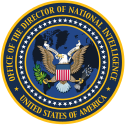 Seal of the Director of National Intelligence | |
| Office of the Director | |
| Style | Madam Director (informal) The Honorable (formal) |
| Member of | Cabinet National Security Council Homeland Security Council |
| Reports to | President |
| Seat | Washington, D.C. |
| Appointer | President with Senate advice and consent |
| Constituting instrument | 50 U.S.C. § 3023 |
| Precursor | Director of Central Intelligence (DCI) |
| Formation | December 17, 2004 |
| First holder | John Negroponte |
| Deputy | Principal Deputy Director |
| Website | www |
President George W. Bush strengthened the role of the DNI on July 30, 2008, with Executive Order 13470,[2] which, among other things, solidified the DNI's authority to set goals for intelligence gathering and analysis and to set policy for intelligence sharing with foreign agencies and for the hiring and firing of senior intelligence officials.[3] The DNI was given further responsibility for the entire IC's whistleblowing and source protection by President Obama via Presidential Policy Directive 19 on October 10, 2012.
Under 50 U.S.C. § 3026, "under ordinary circumstances, it is desirable" that either the director or the principal deputy director of national intelligence be an active-duty commissioned officer in the armed forces or have training or experience in military intelligence activities and requirements. Only one of the two positions can be held by a military officer at any given time. The statute does not specify what rank the commissioned officer will hold during their tenure in either position. The DNI, who is appointed by the president of the United States and is subject to confirmation by the United States Senate, serves at the pleasure of the president.
Upon the inauguration of President Joe Biden, the position was elevated to Cabinet-level. The DNI attends all Cabinet meetings and liaises with the Executive Office of the President of the United States and other Cabinet secretaries in the execution of their duties.
History
Founding
Before the DNI was formally established, the head of the United States Intelligence Community was the director of central intelligence (DCI), who concurrently served as the director of the Central Intelligence Agency (CIA).
The 9/11 Commission recommended establishing the DNI position in its 9/11 Commission Report, not released until July 22, 2004, as it had identified major intelligence failures that called into question how well the intelligence community was able to protect U.S. interests against foreign terrorist attacks.
Senators Dianne Feinstein, Jay Rockefeller and Bob Graham introduced S. 2645 on June 19, 2002, to create the position of Director of National Intelligence. Other similar legislation soon followed. After considerable debate on the scope of the DNI's powers and authorities, the United States Congress passed the Intelligence Reform and Terrorism Prevention Act of 2004 by votes of 336–75 in the House of Representatives, and 89–2 in the Senate. President George W. Bush signed the bill into law on December 17, 2004. Among other things, the law established the DNI position as the designated leader of the United States Intelligence Community and prohibited the DNI from serving as the CIA director or the head of any other intelligence community element at the same time. In addition, the law required the CIA Director to report their agency's activities to the DNI.
Critics say compromises during the bill's crafting led to the establishment of a DNI whose powers are too weak to adequately lead, manage and improve the performance of the intelligence community.[4] In particular, the law left the United States Department of Defense in charge of the National Security Agency (NSA), the National Reconnaissance Office (NRO), and the National Geospatial-Intelligence Agency (NGA).
Appointments
The first director of national intelligence was former U.S. ambassador to Iraq John Negroponte who was appointed on February 17, 2005, by President George W. Bush, subject to confirmation by the U.S. Senate. It was reported that President Bush's first choice for DNI was former director of central intelligence Robert M. Gates, who was serving as president of Texas A&M University, but who declined the offer.[5] Negroponte was confirmed by a Senate vote of 98–2 on April 21, 2005, and he was sworn in by President Bush the same day.
On February 13, 2007, Mike McConnell became the second director of national intelligence, after Negroponte was appointed Deputy Secretary of State. Donald M. Kerr was confirmed by the U.S. Senate to be Principal Deputy Director of National Intelligence on October 4, 2007, and sworn in on October 9, 2007. Kerr, from Virginia, was previously the director of the National Reconnaissance Office and the deputy director for science and technology at the CIA before that. Earlier in his career, he was an assistant director at the FBI, in charge of their Laboratory Division from 1997 to 2001.
On July 20, 2010, President Barack Obama nominated retired Air Force lieutenant general James Clapper as the fourth DNI. Clapper was confirmed by the U.S. Senate on August 5, and replaced acting director David C. Gompert. This followed Obama's dismissal of the third DNI, retired Navy admiral Dennis C. Blair, whose resignation became effective May 28, 2010.[6]
The fifth DNI, Dan Coats, the sixth DNI, John Ratcliffe, and acting DNIs Joseph Maguire, Richard Grenell and Lora Shiao, all served between March 16, 2017, and January 21, 2021, during the administration of President Donald Trump.
The seventh and current DNI is Avril Haines, who took office on January 21, 2021. The first woman to hold the office, she was nominated by President-elect Joe Biden on November 23, 2020[7] and confirmed by the Senate on January 20, 2021.[8]
Website issues
Declan McCullagh at News.com wrote on August 24, 2007, that the DNI site was configured to repel all search engines to index any page at DNI.gov. This effectively made the DNI website invisible to all search engines and in turn, any search queries.[9] Ross Feinstein, Spokesman for the DNI, said that the cloaking was removed as of September 3, 2007. "We're not even sure how (the robots.txt file) got there" – but it was again somehow hidden the next day. On September 7, McCullagh reported that the DNI appeared to be open to web searches again.[10]
Reform initiatives
In September 2007, the Office of the DNI released "Intelligence Community 100 Day & 500 Day Plans for Integration & Collaboration". These plans include a series of initiatives designed to build the foundation for increased cooperation and reform of the U.S. Intelligence Community.[11]
Office of the Director of National Intelligence
The Intelligence Reform and Terrorism Prevention Act of 2004 established the Office of the Director of National Intelligence (ODNI) as an independent agency to assist the DNI. The ODNI's goal is to effectively integrate foreign, military and domestic intelligence in defense of the homeland and of United States interests abroad.[12] The ODNI has about 1,750 employees.[13] Its headquarters are in McLean, Virginia.
On March 23, 2007, DNI Mike McConnell announced organizational changes, which included:
- Elevating Acquisition to a new Deputy DNI position
- Creating a new Deputy DNI for Policy, Plans, and Requirements (replacing the Deputy DNI for Requirements position)
- Establishing an Executive Committee
- Designating the Chief of Staff position as the new Director of the Intelligence Staff
The ODNI continued to evolve under succeeding directors, culminating in an organization focused on intelligence integration across the community.[citation needed]
Organization
The ODNI leadership includes the director, principal deputy director and chief operating officer.[14] In addition, the Director of Defense Intelligence reports to the DNI.
There are two directorates, each led by a Deputy Director of National Intelligence:[14][15]
- Mission Integration Directorate
- Policy & Capabilities Directorate
There are five mission centers, each led by a director of that center:[14][15]
- National Counterproliferation and Biosecurity Center
- National Counterterrorism Center
- National Counterintelligence and Security Center
- Foreign Malign Influence Center
- Cyber Threat Intelligence Integration Center
There are also four oversight offices:[14][15]
- Office of Civil Liberties, Privacy and Transparency (CLPT), led by the Civil Liberties Protection Officer (CLPO)[16]
- Office of Equal Employment Opportunity & Diversity
- Office of the Intelligence Community Inspector General
- Office of General Counsel
Organization seals
- NCBC
- FMIC
- NCTC
- NCSC
- ICIG
- CTIIC
United States Intelligence Community
The USIC comprises 17 intelligence agencies and organizations:
- Air Force Intelligence
- Army Intelligence
- Central Intelligence Agency
- Coast Guard Intelligence
- Defense Intelligence Agency
- Office of Intelligence and Counterintelligence (Department of Energy)
- Office of Intelligence and Analysis (Department of Homeland Security)
- Bureau of Intelligence and Research (Department of State)
- Office of Intelligence and Analysis (Department of the Treasury)
- Office of National Security Intelligence (Drug Enforcement Administration)
- Federal Bureau of Investigation
- Marine Corps Intelligence
- National Geospatial-Intelligence Agency
- National Reconnaissance Office
- National Security Agency
- Naval Intelligence
- Space Force Intelligence
Directors
Position succeeded the Director of Central Intelligence.
| No. | Image | Name | Start | End | Duration | President(s) | |
|---|---|---|---|---|---|---|---|
| 1 |  | John Negroponte | April 21, 2005 | February 13, 2007 | 1 year, 298 days | George W. Bush | |
| 2 | 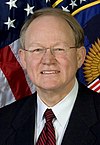 | Mike McConnell | February 13, 2007 | January 27, 2009 | 1 year, 349 days | ||
| 3 | 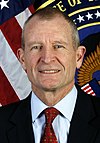 | Dennis Blair | January 28, 2009 | May 28, 2010 | 1 year, 119 days | Barack Obama | |
| – | 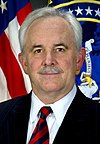 | David Gompert Acting | May 28, 2010 | August 5, 2010 | 69 days | ||
| 4 |  | James Clapper | August 5, 2010 | January 20, 2017 | 6 years, 168 days | ||
| – |  | Mike Dempsey Acting | January 20, 2017 | March 16, 2017 | 55 days | Donald Trump | |
| 5 |  | Dan Coats | March 16, 2017 | August 15, 2019 | 2 years, 152 days | ||
| – |  | Joe Maguire Acting | August 15, 2019 | February 20, 2020 | 189 days | ||
| – |  | Rick Grenell Acting | February 20, 2020 | May 26, 2020 | 96 days | ||
| 6 | 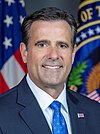 | John Ratcliffe | May 26, 2020 | January 20, 2021 | 239 days | ||
| – |  | Lora Shiao Acting | January 20, 2021 | January 21, 2021 | 1 day | Joe Biden | |
| 7 |  | Avril Haines | January 21, 2021 | Incumbent | 3 years, 97 days | ||
Line of succession
The line of succession for the director of national intelligence is as follows:[17]
- Principal Deputy Director of National Intelligence
- Deputy Director of National Intelligence for Intelligence Integration
- Director of the National Counterterrorism Center
- Director of the National Counterintelligence and Security Center
- Inspector General of the Intelligence Community
Subordinates
Principal Deputy Director of National Intelligence
| Name | Term of office | President(s) served under |
|---|---|---|
| Michael Hayden | April 21, 2005 – May 26, 2006 | George W. Bush |
| Ronald L. Burgess Jr. Acting | June 2006 – October 5, 2007 | |
| Donald Kerr | October 5, 2007 – January 20, 2009 | |
| Ronald L. Burgess Jr. Acting | January 20, 2009 – February 2009 | Barack Obama |
| David C. Gompert | November 10, 2009 – February 11, 2010 | |
| Stephanie O'Sullivan | February 18, 2011 – January 20, 2017 | |
| Susan M. Gordon | August 7, 2017 – August 15, 2019 | Donald Trump |
| Andrew P. Hallmana Acting | October 30, 2019 – February 21, 2020 | |
| Neil Wileya | May 13, 2020 – February 2021 | Donald Trump, Joe Biden |
| Stacey Dixon | August 4, 2021 – present[18] | Joe Biden |
- a.^ Hallman's and Wiley's position was Principal Executive, which did not require Senate confirmation. The duties were the same as those of a principal deputy director.[19]
Chief Operating Officer
| Name | Term of office | President(s) served under |
|---|---|---|
| Deirdre Walsh | February 2018 – May 2020 | Donald Trump |
| Lora Shiao | October 2020 – present | Donald Trump, Joe Biden |
Director of the Intelligence Staff/ Chief Management Officer
| Name | Term of office | President(s) served under |
|---|---|---|
| Ronald L. Burgess Jr. | May 2007 – February 2009 | George W. Bush, Barack Obama |
| John Kimmons | February 2009 – October 2010 | Barack Obama |
| Mark Ewing[citation needed] | November 2010 – n/a | Barack Obama, Donald Trump |
Inspector General of the Intelligence Community
| Name | Term of office | President(s) served under |
|---|---|---|
| Charles McCullough | October 7, 2010 – March 2017[20] | Barack Obama, Donald Trump |
| Michael Atkinson | May 17, 2018 – May 3, 2020[21][22][23] | Donald Trump |
| Thomas Monheim | April 3, 2020[24][25]a – present | Donald Trump, Joe Biden |
- a.^ Monheim became Acting IG upon Atkinson's being put on administrative leave on April 3. He remained Acting IG upon and after Atkinson's official removal on May 3.[25]
Deputy directors of national intelligence
| Name | Office | Term of office | President(s) served under |
|---|---|---|---|
| Beth Sanner | Mission Integration | May 2019[26] – March 2021 | Donald Trump, Joe Biden |
| Kevin Meiners[27] | Enterprise Capacity | n/a – present | Donald Trump |
| Karen Gibson | National Security Partnerships | April 2019[28] – 2020 | Donald Trump |
| Corin Stone[29] | Strategy & Engagement | n/a – present | Donald Trump |
Assistant directors of national intelligence
| Name | Office | Term of Office | President(s) served under |
|---|---|---|---|
| Dr. Ronald Sanders | ADNI for Human Capital | June 2005 - March 2010 | George W Bush, Barack Obama |
| Deborah Kircher | ADNI for Human Capital | October 2011[30] – present | Barack Obama, Donald Trump |
| John Sherman | Intelligence Community Chief Information Officer | September 2017[31] – June 2020[32] | Donald Trump |
| Trey Treadwell[33] | Chief Financial Officer | n/a – present | Donald Trump |
| Catherine Johnston | ADNI for Systems and Resource Analyses | May 2018[34] – present | Donald Trump |
| Roy Pettis[35] | ADNI for Acquisition, Procurement and Facilities | n/a – present | Donald Trump |
| James Smith[36] | ADNI for Policy and Strategy (Acting) | n/a – present | Donald Trump |
See also
- Information Sharing Environment
- Intelligence Advanced Research Projects Activity
- Intellipedia
- Joint Worldwide Intelligence Communications System (JWICS)
- National Intelligence Coordination Center
- The National Security Act of 1947
- Open source intelligence
- Title 32 of the CFR
- United States Joint Intelligence Community Council
- US intelligence community A-Space
- Privacy and Civil Liberties Oversight Board (PCLOB)
References
Further reading
- James R. Clapper with Trey Brown (2018). Facts and Fears: Hard Truths from a Life in Intelligence. New York: Viking. ISBN 978-0525558644. OCLC 1006804896. Memoir including his time as DNI.






